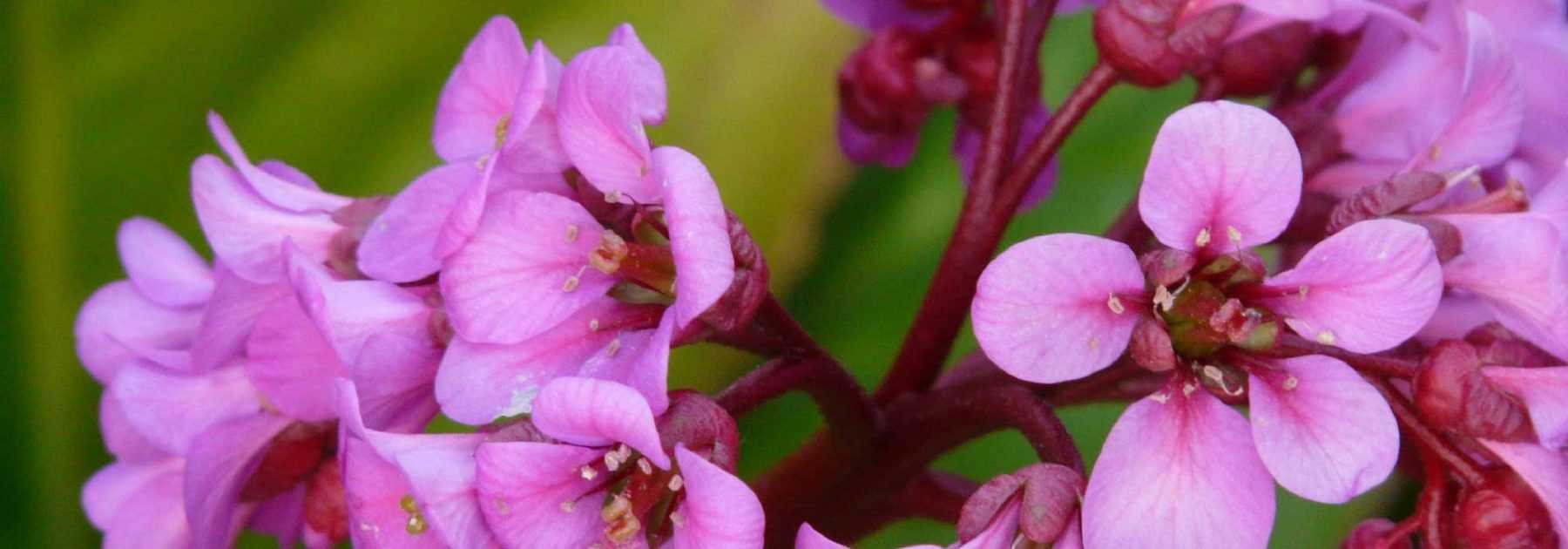
Bergenia, Elephant's Ears: Planting, Growing and Care Guide
Contents
Bergenia in a few words
- Bergenia, also known as “Elephant’s Ears”, is one of the best ground cover plants for partial shade
- Its evergreen foliage remains immaculate all year round
- It fears neither cold nor poor soils
- It’s exceptionally hardy
- Easy to grow, it requires virtually no maintenance
Our expert's word
The Bergenia, also known as “Elephant’s Ears” or “Pigsqueak”, is one of the most exceptional evergreen perennials. Easy to grow and simple to propagate, this generous perennial, elegant and compact, is making a strong comeback in our gardens.
It’s a must-have, highly valued for its beautiful evergreen foliage, tough and ever-changing, green with reddish hues in winter, and its dazzling spring flowering, forming dense clumps of often pink, white or red flowers. From late March for the earliest varieties to mid-June, they will brighten up the garden.
Red bergenia, white bergenia or pink bergenia, from Bergenia crassifolia to Bergenia purpurascens with its purple stems, and Bergenia cordifolia, the most common in our gardens, it always offers a charming display.
Behind its unassuming appearance lies exemplary ease of cultivation and unmatched hardiness, qualities that make it indispensable in any garden.
It thrives in partial shade or non-scorching sun, in well-drained soil, even poor soil, where it slowly forms thick flowering carpets in rockeries as ground cover or at the foot of deciduous shrubs.
If you’re looking for a hardy perennial that’s always beautiful, fall for the bergenia and discover our Bergenia varieties!
Description and botany
Botanical data
- Latin name Bergenia
- Family Saxifragaceae
- Common name Bergenia, plante des savetiers
- Flowering De février à juin
- Height 0,20 à 0,60 cm
- Exposure Soleil, mi-ombre
- Soil type Tous, bien drainés
- Hardiness Au-delà de -15°
The genus Bergenia or Bergenie comprises about 8 species of evergreen, rhizomatous perennial plants from the Saxifragaceae family. The Bergenia, also known as “elephant’s ears”, is native to rocky heathlands and cool woodlands of Central and Eastern Asia, particularly the Altai Mountains in Siberia. In the wild, it only grows in regions with snowy winters.
Bergenia cordifolia, a highly resilient and hardy species, is the most common in our gardens and has given rise to most cultivars and hybrids such as ‘Bressingham White’ or ‘Abendglut’.
Bergenia crassifolia has large, leathery leaves, while Bergenia purpurascens is spectacular with its reddish stems.
This herbaceous perennial has a spreading habit, forming dense, creeping clumps that create a thick mat approximately 20 cm tall and up to 70 cm wide at maturity, with relatively slow growth. It develops gradually as ground cover without becoming invasive.
With its short, thick creeping rhizome, this plant spreads steadily, eventually forming beautiful flowering colonies over time.
Bergenia is highly valued for its lush green foliage that turns red in cold weather. It regenerates in spring. The short stems bear rosettes of tough, evergreen leaves that are shiny, oval, round or heart-shaped at the base, with crinkled or slightly wavy edges. Borne on sheathing petioles, they expand into large, entire leaves measuring 7 to 25 cm long and wide, sometimes nicknamed “pig’s ears” or “elephant’s ears”. While most are smooth, some like Bergenia ciliata have hairy leaves covered in fine hairs.

From left to right: Bergenia ‘Baby Doll’, foliage of Bergenia ‘Abendglut’, Bergenia ‘Morgenrote’.
With vibrant green to dark green upper surfaces, this foliage sometimes features reddish veins and often has a purple-red underside. Lush and green for much of the year, the leaves turn purple-red in autumn and winter, ranging from beetroot red to bronze.
Bergenia offers a stunning early bloom that is sometimes lightly fragrant. From late winter to early spring, numerous flower spikes emerge well above the foliage. The flower buds, nestled in thick brown-pink or crimson calyxes, are borne on sturdy, hairy stems ranging from light brown to purple-red.
Clustered in dense panicles of pendulous flowers at the ends of branched stems, they straighten as they bloom. They open into clouds of small bell-shaped flowers with five petals, measuring 1 to 3 cm across, in white, magenta lilac, soft pink to crimson or purple. Some double or semi-double varieties resemble Japanese cherry blossoms. They make lovely spring bouquets. Flowering may repeat if summers are cool.
Extremely easy to grow, Bergenia tolerates diverse conditions. It thrives in shade, partial shade or gentle sun in any soil type – poor, chalky or rich – as long as it’s well-drained and moist. Hardy and robust, unfazed by cold or snow, it can withstand extreme temperatures down to -35°C to -45°C.

A flower of Bergenia cordifolia visited by a hoverfly.
It makes excellent ground cover, perfect for slopes, rockeries or beneath deciduous trees and shrubs. Plant in groups, in woodland settings or shrub borders with primroses, spring bulbs, heucheras, Lenten roses, or hostas.
Main species and varieties
The Bergenia genus comprises only about ten species. Alongside Bergenia cordifolia, the most common in our gardens and its famous ‘Purpurea’ cultivar with deep magenta-purple flowers, you’ll also find Bergenia crassifolia and the spectacular Bergenia purpurascens with its purple stems, flowers and leaves. Hybrid Bergenia varieties like ‘Abendglut’, ‘Bressingham White’ and ‘Wintermärchen’ complete a selection primarily guided by the sumptuous colours of their leaves and flowers, ranging from pure white to bright carmine pink.

Bergenia cordifolia - Elephant's Ears
- Flowering time April to June
- Height at maturity 40 cm
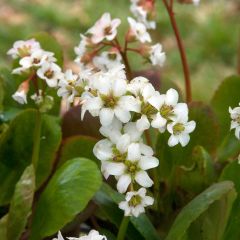
Bergenia Bressingham White - Elephant's Ears
- Flowering time June, July
- Height at maturity 30 cm
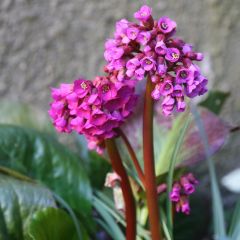
Bergenia purpurascens - Pigsqueak
- Flowering time April, May
- Height at maturity 30 cm

Bergenia Wintermarchen - Elephant's Ears
- Flowering time May, June
- Height at maturity 40 cm
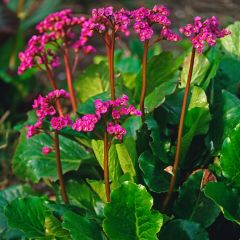
Bergenia cordifolia Morgenrote - Elephant's Ears
- Flowering time April to July
- Height at maturity 40 cm
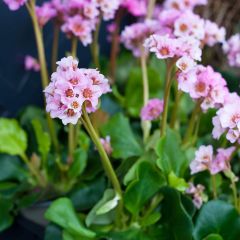
Bergenia Baby Doll - Elephant's Ears
- Flowering time May, June
- Height at maturity 25 cm
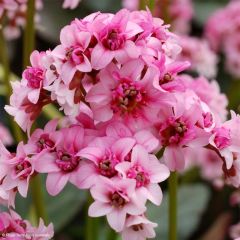
Bergenia Dragonfly Series Sakura - Elephant's Ears
- Flowering time April, May
- Height at maturity 25 cm
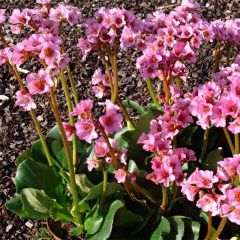
Bergenia Rosenkristall - Elephant's Ears
- Flowering time March, April
- Height at maturity 40 cm
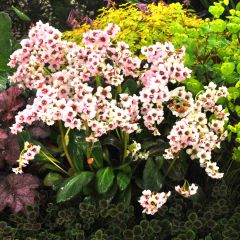
Bergenia Dragonfly Series Angel Kiss - Elephant's Ears
- Flowering time May, June
- Height at maturity 30 cm
Discover other Bergenia
Planting
Where to plant Bergenia
Bergenia is a remarkably undemanding plant. It thrives in all regions, except perhaps in Mediterranean climates, which may be too dry in summer. Avoid strong direct sunlight and very dry soils, as these tend to stunt its growth.
Cold, however, does not faze it. Originating from the Himalayas, it retains excellent hardiness and can withstand very low temperatures down to -35°C. This versatile plant tolerates both sea spray and urban pollution in city gardens.
Adaptable, it accepts all exposures and grows in any soil, preferably moist.
When planted in poor soil, the magnificent colours of its foliage—transitioning from green to red and bronze—will be enhanced throughout winter. It thrives best in fresh, humus-rich, well-drained soil. Heat is not an issue as long as the soil remains cool.
It looks most attractive in partial shade, though it will grow well in non-scorching sunlight. Excessive shade hinders flowering, while overly rich soil promotes foliage at the expense of blooms.
Practical, this ground cover suppresses weed growth. It’s the ideal perennial for filling shaded slopes with minimal maintenance.
It can be used in pots, rockeries, borders, or at the base of deciduous shrubs, which will shield it from summer heat. Planted in groups of 3 or 5, it eventually forms vigorous, floriferous clumps.
When to plant Bergenia
Bergenia is best planted in spring (March–April or May) after the last frosts or, in mild climates, from September to November.
How to plant Bergenia
The soil should be well loosened before planting Bergenia. Slow to establish, it rewards patience—once settled after about two years, it offers long-lasting beauty and increasingly generous blooms. It prefers soil that stays cool in summer, especially in its early years (though it tolerates drought better with age), but must be well-drained.
Space plants 30–40 cm apart to allow clumps to spread comfortably. Plan for 5–6 pots per m²—given this perennial’s lush growth, this ensures a striking display.
Consider planting small spring bulbs (Galanthus, Crocus, Chionodoxa, etc.) between Bergenia clumps to fill gaps while they mature.
- Clear the soil of stones, roots, and weeds
- Loosen and work the soil thoroughly
- Dig a hole 2–3 times the pot’s volume
- Plant in a mix of well-rotted compost and garden soil
- Water regularly for the first six weeks to encourage rooting
- Mulch in spring with pine bark to retain soil moisture
- Protect young shoots from slugs and snails in spring; use fern-based slug repellent if needed
→ Explore our guide to growing Bergenia in pots
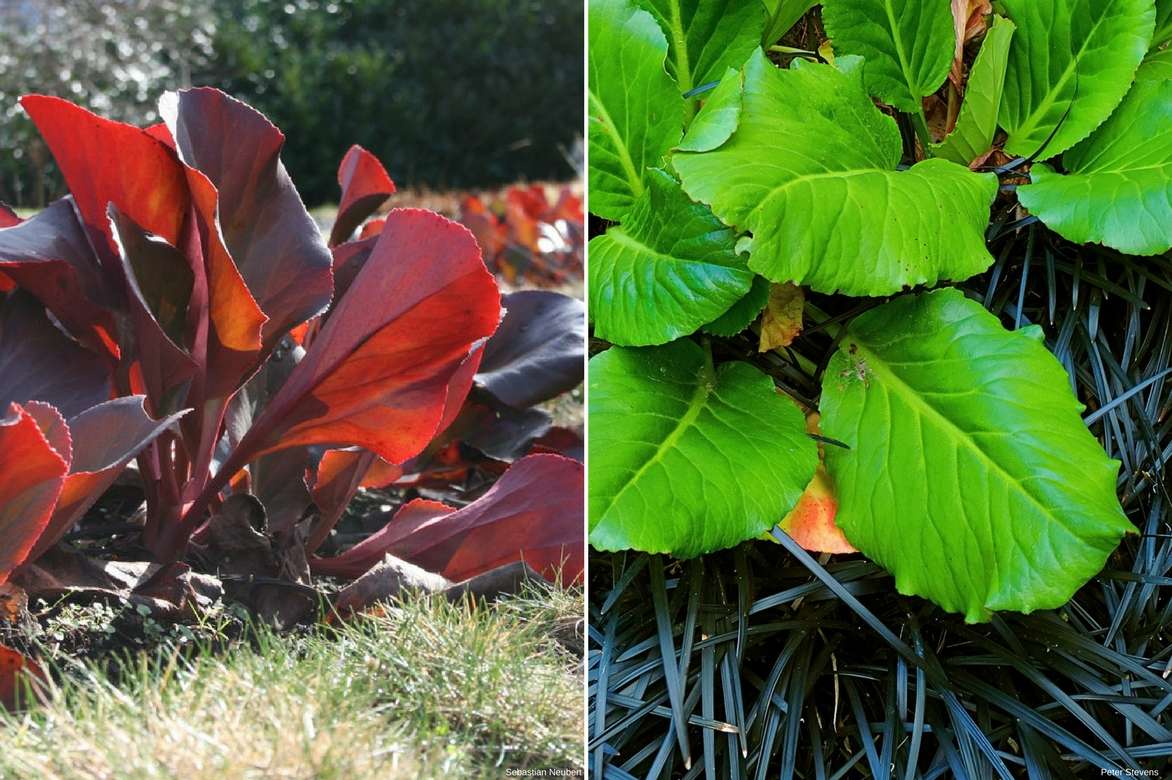
Left to right: Striking red foliage of Bergenia cordifolia ‘Amiral’ – Bergenia paired with Ophiopogon planiscapus ‘Nigrescens‘.
Care, Pruning and Maintenance of Bergenia
Bergenia requires almost no maintenance and proves to be a trouble-free perennial with exceptional hardiness. It can thrive for many decades without any care, provided the soil remains well-drained and cool in summer. Easy to grow and generous, it fears neither cold nor snow, which offers excellent protection to its foliage.
While Bergenia adapts easily to all soil types, it tolerates very dry soils rather poorly. Water regularly once or twice a week during the first summer after planting. Then, water during heatwaves to keep the soil consistently moist. Apply a good organic mulch in early spring, especially in the first few years after planting.
Pruning isn’t necessary, though a light spring clean-up can be beneficial. In March, remove all old dry or blackened leaves. Trim away faded leaves as needed.
Cut back flower stalks just after blooming to better showcase the foliage.
Although it thrives in relatively poor soil, adding organic compost in early spring will boost its growth and enhance flowering.
Diseases and potential pests
When planted in well-drained soil, the Bergenia proves to be very resilient.
Rarely affected by diseases, it has few enemies: gastropods at the start of the growing season and vine weevil larvae when grown in pots.
When cultivated in pots, its rhizomes and roots may be eaten by vine weevil larvae. In spring, spray a nematode-based solution, available from specialist garden centres. The nematode, a microscopic worm, will parasitise the vine weevil larvae, which will be consumed within a few weeks. In the garden, vine weevil larvae are not a problem as they are eaten by many beneficial animals, particularly birds and hedgehogs.
Occasionally, leaf spots caused by fungal diseases may appear. To prevent them, plant your bergenias with sufficient space between them, following the recommended planting distances. Removing affected leaves is essential to prevent spread. As a preventive measure, regularly spray horsetail or nettle manure.
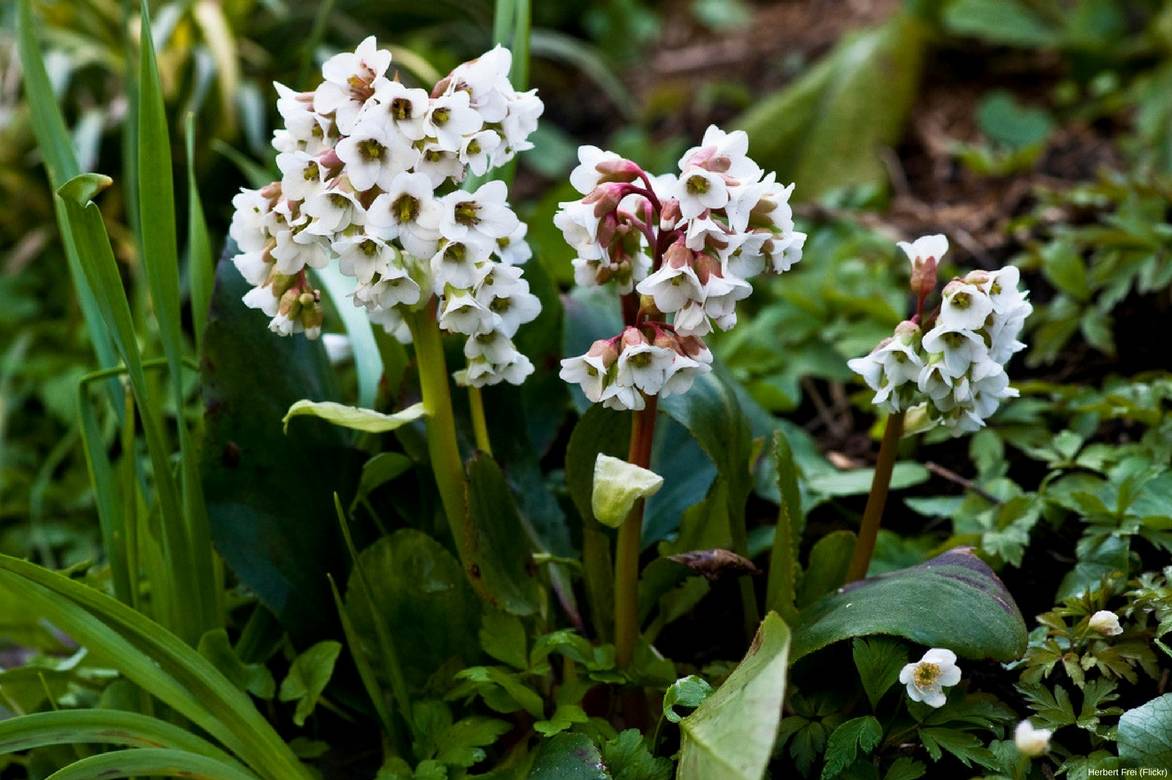
The delicate pure white bells of Bergenia ‘Bressingham White’.
Multiplying bergenias
The Bergenia can be divided very easily. Over the years, the plant may show signs of fatigue and sparser flowering: after 4-5 years, in spring or autumn, divide the largest clumps that are at least three years old to rejuvenate the plant and maintain beautiful blooms.
- Using a spade, remove a rhizome from the edge of the clump, ensuring it has a rosette of leaves
- Replant the rhizome divisions immediately in well-prepared garden soil
Pairing
The Bergenia proves indispensable in a woodland garden. Spring-flowering perennials such as hardy geraniums, Cyclamen coum, early crocuses, winter heaths, snowdrops and winter aconites are its perfect companions.
In a flower bed, it will work wonders when paired with early-flowering daffodils and other spring bulbs.
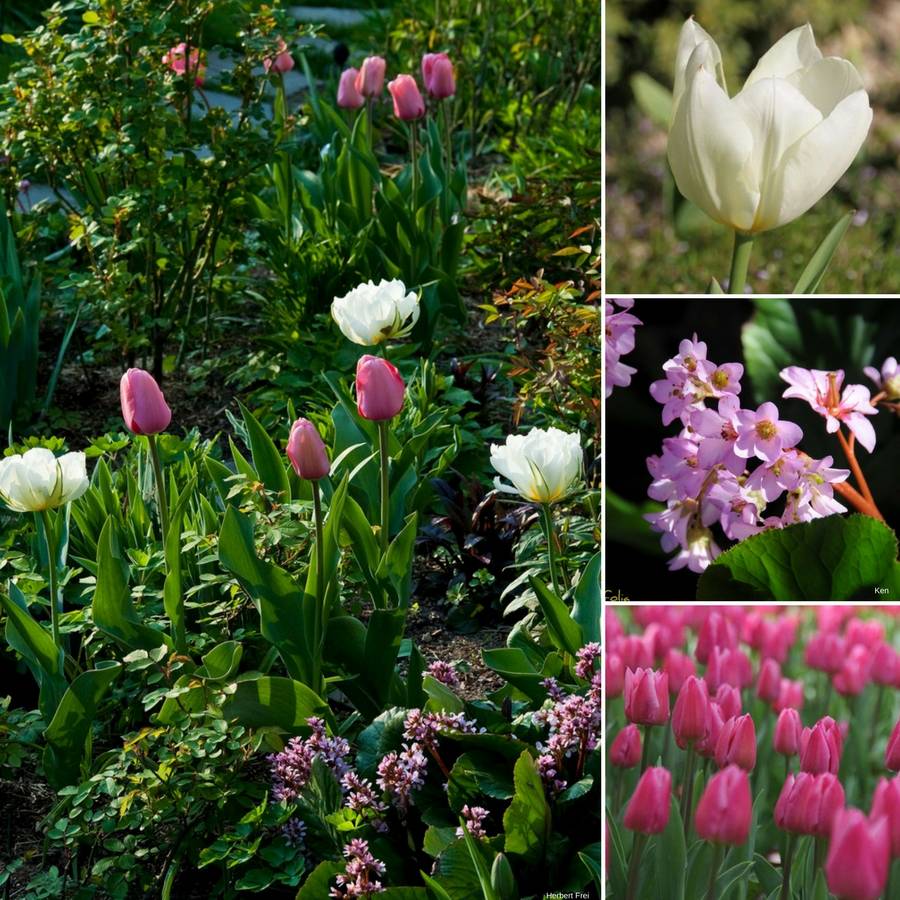

A spring planting idea: Bergenia cordifolia paired with early tulips such as T. ‘Christmas Dream’ and T. fosteriana ‘Purissima’.
It can be planted in the foreground of more loosely structured plants like asters or phlox, which will spread above its foliage for much of the year.
For covering a slope, it pairs perfectly with creeping bugle, hepaticas, primroses, and in light woodland settings, with epimediums and Lenten roses.
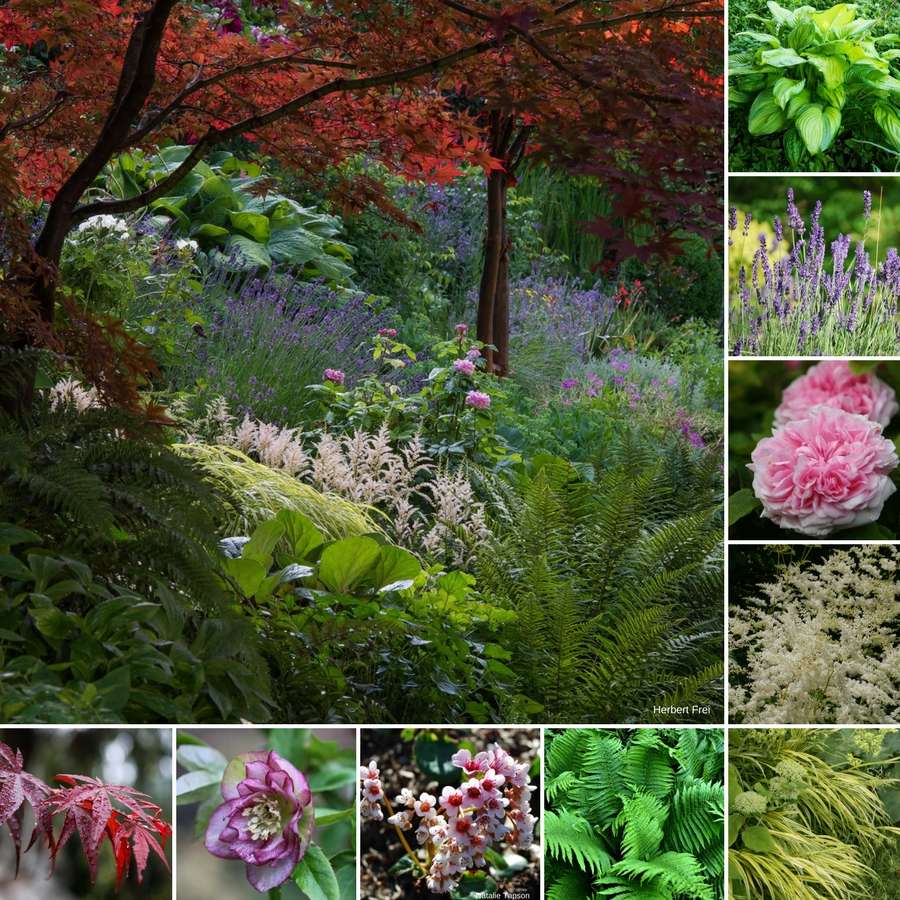

An example planting scheme for a partially shaded slope: Acer palmatum ‘Atropurpureum’, Helleborus orientalis, Bergenia ciliata, Dryopteris filix-mas, Hakonechloa macra ‘Aureola’, Astilbe simplicifolia ‘Sprite’, Rosa ‘Jacques Cartier’, Lavandula, Hosta ‘Guacamole’.
In a rock garden with light shade, it also works well with heucheras, hostas, and small evergreen shrubs like euonymus or winter-stemmed dogwoods.
Consider pairing it with foliage plants that provide contrasting forms, such as ornamental grasses, sedges, stipas or ferns.
Useful resources
- Discover our new bergenias, including some exclusive varieties
- Explore our selection of the 6 most beautiful Bergenia varieties
- Choose spring-flowering perennials to complement your bergenias
- Our advice sheet: 6 Pink-flowered Bergenias
- Our advice sheet: How to grow Bergenia in pots?
- Our advice sheet: How to choose a bergenia?
- Our advice sheet: Bergenia diseases and pests
- Our advice sheet: 7 Bergenias with beautiful autumn colours
- Discover 6 late winter-flowering perennials
Frequently asked questions
-
Why isn't my Bergenia flowering?
The Bergenia is a generous perennial that is usually very floriferous. A Bergenia that doesn't flower is likely planted in soil that's too rich or in too shady a spot. Dense shade hinders its flowering – it needs sunlight to bloom well.
- Subscribe!
- Contents


































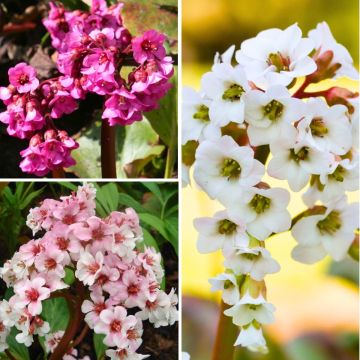

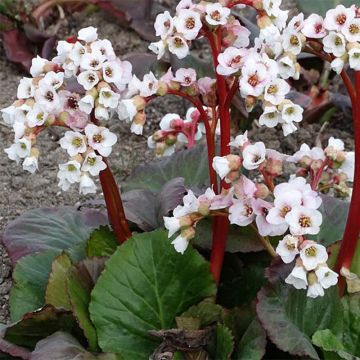
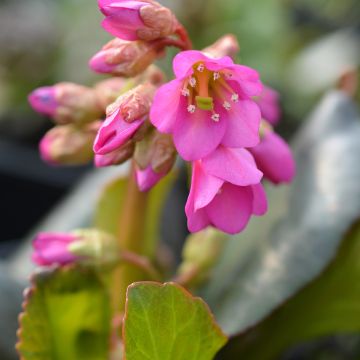
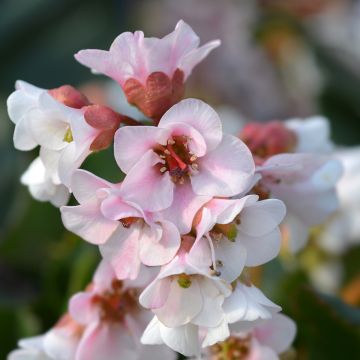

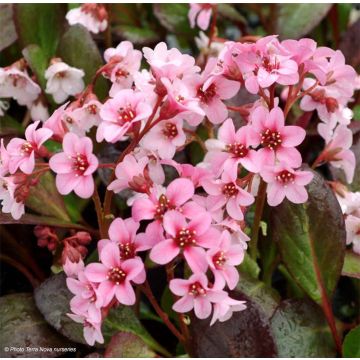



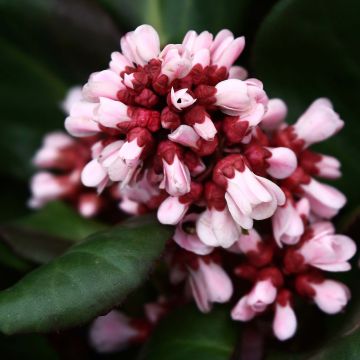
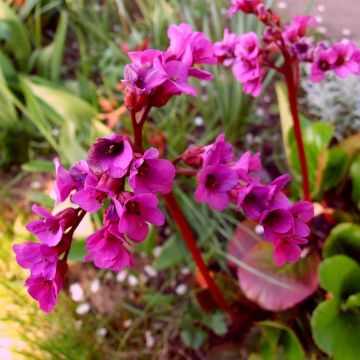
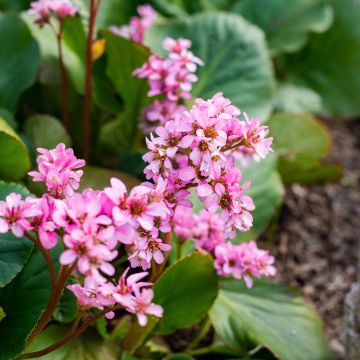
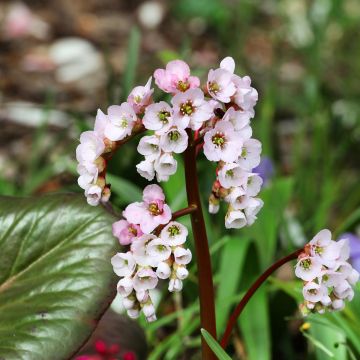

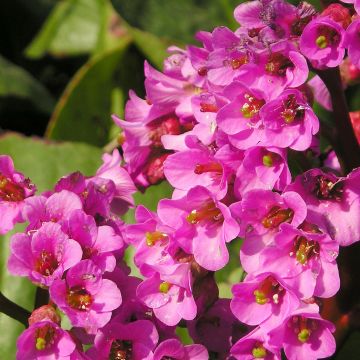
Comments